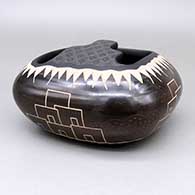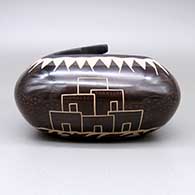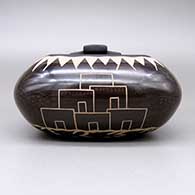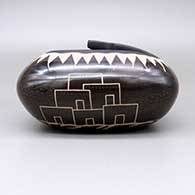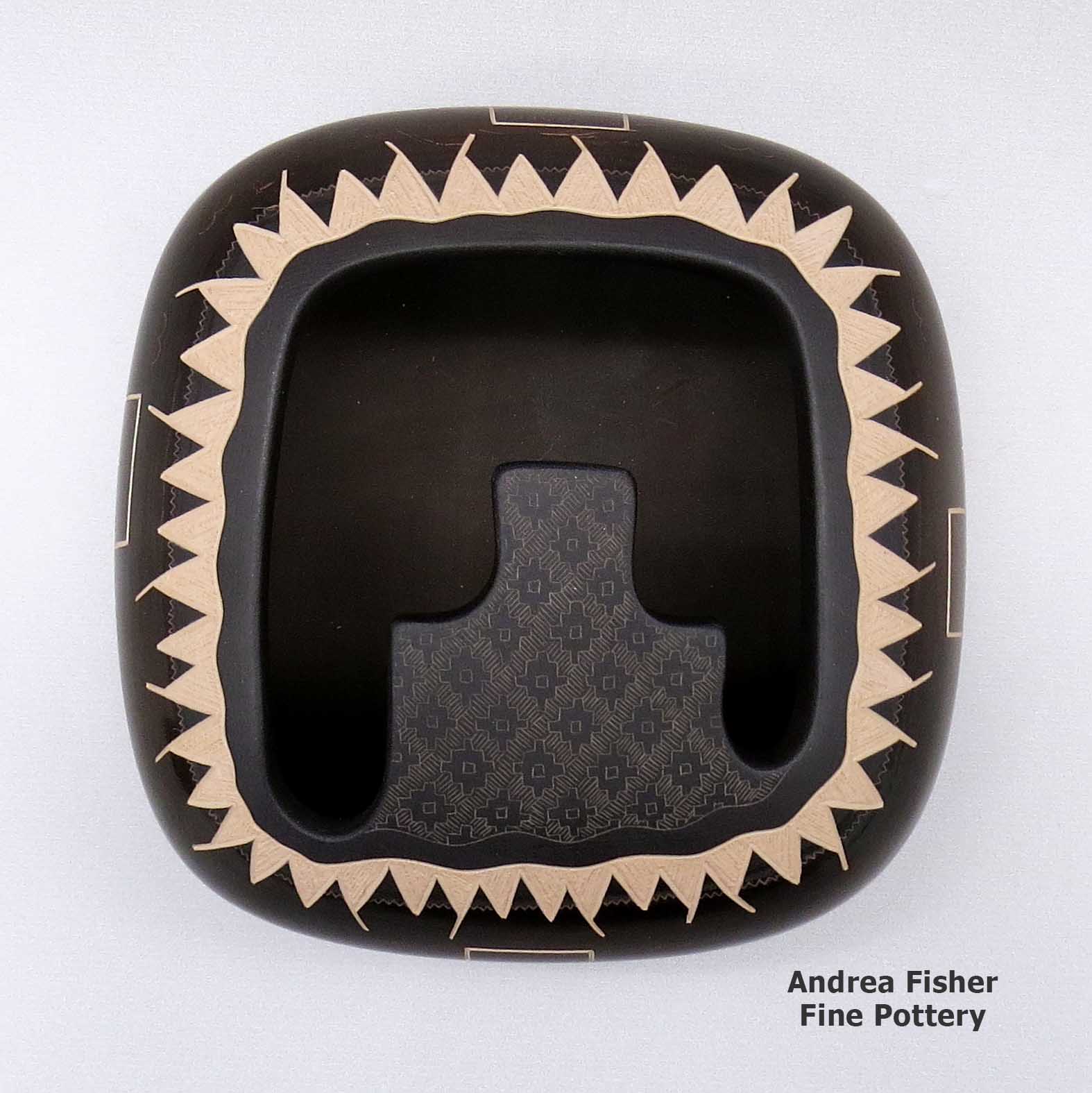
Santa Clara
$ 1250
chsc4a255
Sienna bowl with a square-shaped body, a distinctive kiva step geometric cut opening, and a four-panel sgraffito pueblo, mountain, hill, fish, and geometric design
5.5 in L by 5.5 in W by 3.25 in H
Condition: Very good, rubbing and scratches on bottom and side
Signature: Jody Naranjo, with date
Date Created: 2012
Tell me more! Buy this piece!
(505) 986-1234 - www.andreafisherpottery.com - All Rights Reserved
Jody Naranjo
Santa Clara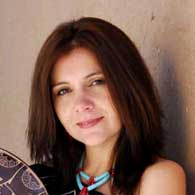
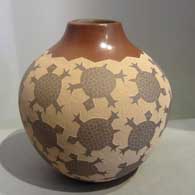
Born into Santa Clara Pueblo in 1969, Jody Naranjo is a traditional potter creating contemporary styles and designs. She learned the ancient way of making pottery mostly from her mother, Dolly Naranjo-Neikrug, with influences from her aunt Jody Folwell and her cousin Roxanne Swentzell. She counts herself an eighth-generation Pueblo potter, still using the polishing stone used by her great-great-grandmother.
The traditional Pueblo manner of teaching is through play. Jody was playing with clay very early in life and says she was well practiced in just about every aspect of creating pottery before she was six. By the time she was 15 her pottery was being sold through the New Mexico History Museum. At 19 she attended the Institute of American Indian Arts on a fellowship from the Southwestern Association of Indian Arts and at the age of 23 she earned the First Place ribbon for Contemporary Sgraffito at the Santa Fe Indian Market. Her career took off from there.
Jody has earned a long list of top awards at the nation's leading venues since, including scores of First Place, Best of Division and Best of Class awards at the Santa Fe Indian Market, the Eiteljorg Museum of American Indians and Western Art in Indianapolis and the Heard Museum Guild Indian Fair and Market in Phoenix.
In 2017 the Museum of Indian Arts and Culture declared Jody to be a Native Treasures Living Treasure.
Some Exhibits that Featured Pieces by Jody
- Pueblo Dynasties: Master Potters from Matriarchs to Contemporaries. Crocker Art Museum. Sacramento, California. September 15, 2019 - January 5, 2020. Note: exhibition focuses on legendary matriarchs such as Nampeyo, Maria Martinez and Margaret Tafoya
- Preston Singletary: Artist, Innovator, Collaborator. Blue Rain Gallery. Santa Fe, New Mexico. Opened August 6, 2019. Note: includes collaborative works by Preston Singletary with Harlan Reano, Jody Naranjo, and Tammy Garcia
- What's New in New: Selections from the Carol Warren Collection. Lloyd Kiva New Gallery, Museum of Indian Arts and Culture. Santa Fe, New Mexico. June 3, 2018 - February 26, 2019. Note: exhibiting works include art by artists Tony Abeyta, Autumn Borts-Medlock, Preston Duwyenie, Tammy Garcia, Dan Namingha, Les Namingha, Jody Naranjo, Roxanne Swentzell, and Tito Naranjo
- Hold Everything! Masterworks of Basketry and Pottery from the Heard Museum. Heard Museum. Phoenix, Arizona. November 1, 2001 - March 10, 2002
- Preston Singletary and Jody Naranjo: a Collaboration in Glass. SOFA Chicago. Chicago, Illinois. October 31, 2013 - November 3, 2013
Some of the Other Awards Jody has Earned
- 2020 Heard Museum Guild Indian Fair & Market, Classification II - Pottery, Division F - Any design or form with non-native materials, includes kiln-fired pottery: First Place. Awarded for the artwork: "Lightning Storms"
- 2020 Heard Museum Guild Indian Fair & Market, Classification II - Pottery, Division F - Any design or form with non-native materials, includes kiln-fired pottery: Second Place. Awarded for the artwork: "Girl Friends"
- 2018 Eiteljorg Museum Indian Market and Festival: Helen Box Kersting Award. Awarded for a pottery piece: "Metallic Butterflies"
- 2018 Eiteljorg Museum Indian Market and Festival, Pottery: Best of Division. Awarded for artwork: "Santa Clara Feast Day"
- 2018 Governor's Award for Excellence in the Arts. New Mexico Governor and New Mexico Arts Commission
- 2017 Santa Fe Indian Market, Classification II - Pottery, Division E - Contemporary Pottery, any form or design, using commercial clays/glazes, all firing techniques, Category 906 - Sgraffitto and carved, any form: First Place
- 2016 Heard Museum Guild Indian Fair & Market: Best of Show with Glendora Fragua. Award for artwork: "Pueblo Luck"
- 2016 Heard Museum Guild Indian Fair & Market, Classification II - Pottery: Best of Classification with Glendora Fragua. Award for artwork: "Pueblo Luck"
- 2016 Heard Museum Guild Indian Fair & Market, Classification II - Division A - Traditional, Native Clay, Hand Built, Painted: First Place with Glendora Fragua. Award for artwork: "Pueblo Luck"
- 2016 Heard Museum Guild Indian Fair & Market Judge's Choice Award by Heather Lineberry. Award for: "Landscape"
- 2016 Heard Museum Guild Indian Fair & Market Guild 60th Anniversary: Theme Award - Contemporary Pottery. Award for: "Old & New"
- 2013 Heard Museum Guild Indian Fair & Market, Classification II - Pottery, Division E - Non-traditional design or form with native materials: First Place
- 2013 Heard Museum Guild Indian Fair & Market: Judge's Choice Award by Catherine Black Horse. Awarded for artwork: "Prehistoric Pottery"
- 2012 Heard Museum Guild Indian Fair & Market, Classification II - Pottery, Division F - Non-traditional design or form with native materials: Second Place
- 2011 Heard Museum Guild Indian Fair & Market: Judge's Choice Award by Linda Lomahaftewa. Awarded for artwork: "Putting All Your Ducks in a Row"
- 2010 Eiteljorg Museum Indian Market: Best of Show, collaborative work with Dominique Toya. Awarded for artwork: "Double Insanity"
- 2010 Eiteljorg Museum Indian Market, Division 5 - Pottery: Best of Division collaborative work with Dominique Toya. Awarded for artwork: "Double Insanity"
- 2010 Eiteljorg Museum Indian Market, Division 5 - Pottery, Category 501 - Traditional: Second Place. Awarded for artwork: "Please Give Us Rain"
- 2010 Eiteljorg Museum Indian Market, Division 5 - Pottery, Category 502 - Contemporary: First Place for collaborative work with Dominique Toya. Awarded for artwork: "Double Insanity"
- 2010 Heard Museum Guild Indian Fair & Market, Classification II - Pottery, Division C - Traditional native clay, hand built, carved: First Place
- 2010 Heard Museum Guild Indian Fair & Market: Judge's Choice Award by Helen Kersting with Dominique Toya. Awarded for artwork: "Double Insanity"
- 2009 Heard Museum Guild Indian Fair & Market, Classification II - Pottery, Division E - Non-traditional design or form with native materials: Honorable Mention
- 2009 Heard Museum Guild Indian Fair & Market: Judge's Choice Award by Christina Burke. Awarded for Round Vase: "Losing Direction"
- 2007 Heard Museum Guild Indian Fair & Market, Classification II - Pottery, Division C - Traditional, native clay, hand built, carved, including ribbed and incised: Honorable Mention
- 2007 Heard Museum Guild Indian Fair & Market, Classification II - Pottery, Division F - Non-traditional design or form with non-native materials: Honorable Mention
- 2007 Heard Museum Guild Indian Fair & Market: Judge's Choice Award by Christina Burke. Awarded for pottery: "Pueblo Constellation"
- 2007 Heard Museum Guild Indian Fair & Market: Judge's Choice Award - Jim Calfee. Awarded for pottery: "Pueblo Constellation"
- 2006 Heard Museum Guild Indian Fair & Market, Classification II - Pottery, Division B - Traditional, native clay, hand built, unpainted: Second Place
- 2006 Heard Museum Guild Indian Fair & Market: Judge's Choice Award by David Dear. Awarded for artwork: "Honey, I'm Home"
- 2005 Heard Museum Guild Indian Fair & Market, Class. VIII - Pottery, Division B - Traditional/Native Clay/Hand-Built (Unpainted): Best of Division. Awarded for "Naranjo Family Portraits"
- 2003 Heard Museum Guild Indian Fair & Market, Classification VIII - Pottery, Division B - Traditional, native clay, hand built, unpainted: Best of Division
- 2003 Heard Museum Guild Indian Fair & Market: Judge's Choice Award by David McFadden
- 2002 Heard Museum Guild Indian Fair & Market, Classification VIII - Pottery, Division B - Traditional, native clay, hand built, unpainted: Honorable Mention
- 2001 Heard Museum Guild Indian Fair & Market, Classification VI - Pottery, Division B - Traditional, native clay, hand build, unpainted: Honorable Mention
- 2000 Santa Fe Indian Market, Classification II - Pottery, Division G - Non-traditional pottery, new forms using traditional materials and techniques, Category 1403 - Sgraffito style without stones, any other color including red two-tone: Second Place
- 2000 Santa Fe Indian Market, Classification II - Pottery, Division G - Non-traditional pottery, new forms using traditional materials and techniques, Category 1403 - Sgraffito style without stones, any other color including red two-tone: Third Place
- 1999 Heard Museum Guild Indian Fair & Market, Classification VII - Pottery, Division B - Traditional, native clay, hand built, unpainted: Best of Division
- 1998 Santa Fe Indian Market, Classification II - Pottery, Division G - Non-traditional pottery, new forms, using traditional materials and techniques: Best of Division
- 1998 Santa Fe Indian Market, Classification II - Pottery, Division G - Non-traditional pottery, new forms, using traditional materials and techniques, Category 1402 - Sgraffito style without stones, red: First Place
- 1998 Santa Fe Indian Market, Classification II - Pottery, Division G - Non-traditional pottery, new forms, using traditional materials and techniques, Category 1403 - Sgraffito style without stones, any other color including red two-tone: First Place
- 1998 Santa Fe Indian Market, Class. II - Pottery, Division G - Non-traditional pottery, new forms, using traditional materials and techniques, Category 1403 - Sgraffito style without stones, any other color including red two-tone: Second Place
- 1998 Heard Museum Guild Indian Fair & Market, Classification VI - Pottery, Division B - Traditional, native clay, hand built, unpainted: Honorable Mention
- 1997 Santa Fe Indian Market, Class. II - Pottery, Div. H - Non-traditional, any forms using non-traditional materials and techniques, Cat. 1403 - Sgraffito style, First Place, Third Place
- 1997 Heard Museum Guild Indian Fair & Market, Classification VII - Pottery, Division B - Traditional, native clay, hand build, unpainted: Honorable Mention
- 1993 Santa Fe Indian Market, Class. II - Pottery, Div. H - Non-traditional pottery, new forms using traditional materials and techniques, Cat. 1502 - Sgraffito style with or without stones, any color except black, Third Place
- 1992 Santa Fe Indian Market, Classification II - Pottery, Division H - Non-traditional Pottery, New Forms Using Traditional Materials and Techniques, Category 1502 - Sgraffito Style with or without Stones, Any Color except Black: First Place
Santa Clara Pueblo

Ruins at Puye Cliffs, Santa Clara Pueblo
Santa Clara Pueblo straddles the Rio Grande about 25 miles north of Santa Fe. Of all the pueblos, Santa Clara has the largest number of potters.
The ancestral roots of the Santa Clara people have been traced to the pueblos in the Mesa Verde region in southwestern Colorado. When that area began to get dry between about 1100 and 1300, some of the people migrated to the Chama River Valley and constructed Poshuouinge (about 3 miles south of what is now Abiquiu on the edge of the mesa above the Chama River). Eventually reaching two and three stories high with up to 700 rooms on the ground floor, Poshuouinge was inhabited from about 1375 to about 1475. Drought then again forced the people to move, some of them going to the area of Puye (on the eastern slopes of the Pajarito Plateau of the Jemez Mountains) and others to Ohkay Owingeh (San Juan Pueblo, along the Rio Grande). Beginning around 1580, drought forced the residents of the Puye area to relocate closer to the Rio Grande and they founded what we now know as Santa Clara Pueblo on the west bank of the river, between San Juan and San Ildefonso Pueblos.
In 1598 Spanish colonists from nearby Yunque (the seat of Spanish government near San Juan Pueblo) brought the first missionaries to Santa Clara. That led to the first mission church being built around 1622. However, the Santa Clarans chafed under the weight of Spanish rule like the other pueblos did and were in the forefront of the Pueblo Revolt of 1680. One pueblo resident, a mixed black and Tewa man named Domingo Naranjo, was one of the rebellion's ringleaders. When Don Diego de Vargas came back to the area in 1694, he found most of the Santa Clarans on top of nearby Black Mesa (with the people of San Ildefonso). An extended siege didn't subdue them so eventually, the two sides negotiated a treaty and the people returned to their pueblo. However, successive invasions and occupations by northern Europeans took their toll on the tribe over the next 250 years. The Spanish flu pandemic in 1918 almost wiped them out.
Today, Santa Clara Pueblo is home to as many as 2,600 people and they comprise probably the largest per capita number of artists of any North American tribe (estimates of the number of potters run as high as 1-in-4 residents).
Today's pottery from Santa Clara is typically either black or red. It is usually highly polished and designs might be deeply carved or etched ("sgraffito") into the pot's surface. The water serpent, ("avanyu"), is a traditional design motif of Santa Clara pottery. Another motif comes from the legend that a bear helped the people find water during a drought. The bear paw has appeared on their pottery ever since.
One of the reasons for the distinction this pueblo has received is because of the evolving artistry the potters have brought to the craft. Not only did this pueblo produce excellent black and redware, several notable innovations helped move pottery from the realm of utilitarian vessels into the domain of art. Different styles of polychrome redware emerged in the 1920's-1930's. In the early 1960's experiments with stone inlay, incising and double firing began. Modern potters have also extended the tradition with unusual shapes, slips and designs, illustrating what one Santa Clara potter said: "At Santa Clara, being non-traditional is the tradition." (This refers strictly to artistic expression; the method of creating pottery remains traditional).
Santa Clara Pueblo is home to a number of famous pottery families: Tafoya, Baca, Gutierrez, Naranjo, Suazo, Chavarria, Garcia, Vigil, Tapia - to name a few.



Santa Clara Pueblo at Wikipedia
Pueblos of the Rio Grande, Daniel Gibson, ISBN-13:978-1-887896-26-9, Rio Nuevo Publishers, 2001
Upper photo courtesy of Einar Kvaran, Creative Commons Attribution-Share Alike 3.0 Unported License
Rose Naranjo Family Tree
Disclaimer: This "family tree" is a best effort on our part to determine who the potters are in this family and arrange them in a generational order. The general information available is questionable so we have tried to show each of these diagrams to living members of each family to get their input and approval, too. This diagram is subject to change should we get better info.
- Rose Naranjo (1915-2004) & Michael Edward Naranjo
- Jody Folwell (1942-) & Hank Folwell
- Paul Folwell (1962-)
- Polly Rose Folwell (1962-)
- Jody Sue Folwell (1991-)
- Susan Folwell (1970-)
- Dolly Naranjo-Neikrug (1947-) & Marc Neikrug
- Jody Naranjo (1969-)
- Elijah Naranjo Smith (1978-)
- Nora Naranjo-Morse (1953-) & Greg Morse
- Tito Naranjo & Bernice Suazo Naranjo
- Dusty Naranjo (1968-)
- Forrest Naranjo/Caroline Elliot
- Johnathan Naranjo (1987-)
- Rina Swentzell (d. 2015)
- Roxanne Swentzell (1962-)
- Edna Romero (moved to Taos Pueblo)
Some of the above info is drawn from Pueblo Indian Pottery, 750 Artist Biographies, by Gregory Schaaf, © 2000, Center for Indigenous Arts & Studies
Other info is derived from personal contacts with family members and through interminable searches of the Internet.
Copyright © 1998-2024 by


